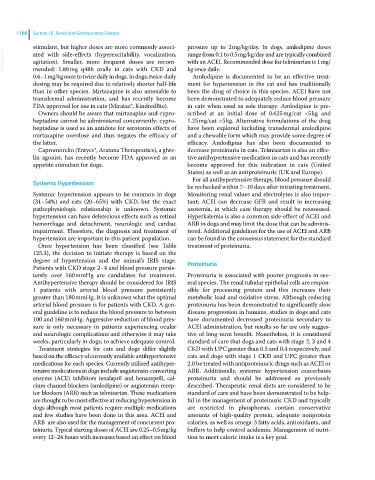Page 1230 - Clinical Small Animal Internal Medicine
P. 1230
1168 Section 10 Renal and Genitourinary Disease
stimulant, but higher doses are more commonly associ- pressure up to 2 mg/kg/day. In dogs, amlodipine doses
VetBooks.ir ated with side‐effects (hyperexcitability, vocalization, range from 0.1 to 0.5 mg/kg/day and are typically combined
with an ACEI. Recommended dose for telmisartan is 1 mg/
agitation). Smaller, more frequent doses are recom-
mended: 1.88 mg q48h orally in cats with CKD and
Amlodipine is documented to be an effective treat-
0.6–1 mg/kg once to twice daily in dogs. In dogs, twice‐daily kg once daily.
dosing may be required due to relatively shorter half‐life ment for hypertension in the cat and has traditionally
than in other species. Mirtazapine is also amenable to been the drug of choice in this species. ACEI have not
transdermal administration, and has recently become been demonstrated to adequately reduce blood pressure
FDA approved for use in cats (Mirataz®, KindredBio). in cats when used as sole therapy. Amlodipine is pre-
Owners should be aware that mirtazapine and cypro- scribed at an initial dose of 0.625 mg/cat <5 kg and
heptadine cannot be administered concurrently; cypro- 1.25 mg/cat >5 kg. Alternative formulations of the drug
heptadine is used as an antidote for serotonin effects of have been explored including transdermal amlodipine
mirtazapine overdose and thus negates the efficacy of and a chewable form which may provide some degree of
the latter. efficacy. Amlodipine has also been documented to
Capromorelin (Entyce®, Aratana Therapeutics), a ghre- decrease proteinuria in cats. Telmisartan is also an effec-
lin agonist, has recently become FDA approved as an tive antihypertensive medication in cats and has recently
appetite stimulant for dogs. become approved for this indication in cats (United
States) as well as an antiproteinuric (UK and Europe).
For all antihypertensive therapy, blood pressure should
Systemic Hypertension
be rechecked within 7–10 days after initiating treatment.
Systemic hypertension appears to be common in dogs Monitoring renal values and electrolytes is also impor-
(31–54%) and cats (20–65%) with CKD, but the exact tant; ACEI can decrease GFR and result in increasing
pathophysiologic relationship is unknown. Systemic azotemia, in which case therapy should be reassessed.
hypertension can have deleterious effects such as retinal Hyperkalemia is also a common side‐effect of ACEI and
hemorrhage and detachment, neurologic and cardiac ARB in dogs and may limit the dose that can be adminis-
impairment. Therefore, the diagnosis and treatment of tered. Additional guidelines for the use of ACEI and ARB
hypertension are important in this patient population. can be found in the consensus statement for the standard
Once hypertension has been classified (see Table treatment of proteinuria.
125.3), the decision to initiate therapy is based on the
degree of hypertension and the animal’s IRIS stage. Proteinuria
Patients with CKD stage 2–4 and blood pressure persis-
tently over 160 mmHg are candidates for treatment. Proteinuria is associated with poorer prognosis in sev-
Antihypertensive therapy should be considered for IRIS eral species. The renal tubular epithelial cells are respon-
1 patients with arterial blood pressure persistently sible for processing protein and this increases their
greater than 180 mmHg. It is unknown what the optimal metabolic load and oxidative stress. Although reducing
arterial blood pressure is for patients with CKD. A gen- proteinuria has been demonstrated to significantly slow
eral guideline is to reduce the blood pressure to between disease progression in humans, studies in dogs and cats
100 and 160 mmHg. Aggressive reduction of blood pres- have documented decreased proteinuria secondary to
sure is only necessary in patients experiencing ocular ACEI administration, but results so far are only sugges-
and neurologic complications and otherwise it may take tive of long‐term benefit. Nonetheless, it is considered
weeks, particularly in dogs, to achieve adequate control. standard of care that dogs and cats with stage 2, 3 and 4
Treatment strategies for cats and dogs differ slightly CKD with UPC greater than 0.5 and 0.4 respectively, and
based on the efficacy of currently available antihypertensive cats and dogs with stage 1 CKD and UPC greater than
medications for each species. Currently utilized antihyper- 2.0 be treated with antiproteinuric drugs such as ACEI or
tensive medications in dogs include angiotensin‐converting ARB. Additionally, systemic hypertension exacerbates
enzyme (ACE) inhibitors (enalapril and benazepril), cal- proteinuria and should be addressed as previously
cium channel blockers (amlodipine) or angiotensin recep- described. Therapeutic renal diets are considered to be
tor blockers (ARB) such as telmisartan. These medications standard of care and have been demonstrated to be help-
are thought to be most effective at reducing hypertension in ful in the management of proteinuric CKD and typically
dogs although most patients require multiple medications are restricted in phosphorus, contain conservative
and few studies have been done in this area. ACEI and amounts of high‐quality protein, adequate nonprotein
ARB are also used for the management of concurrent pro- calories, as well as omega‐3 fatty acids, antioxidants, and
teinuria. Typical starting doses of ACEI are 0.25–0.5 mg/kg buffers to help control acidemia. Management of nutri-
every 12–24 hours with increases based on effect on blood tion to meet caloric intake is a key goal.

